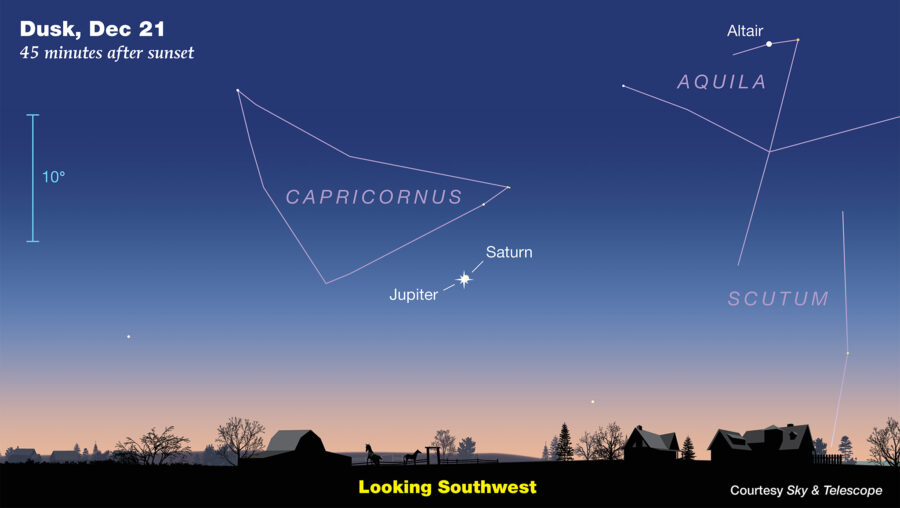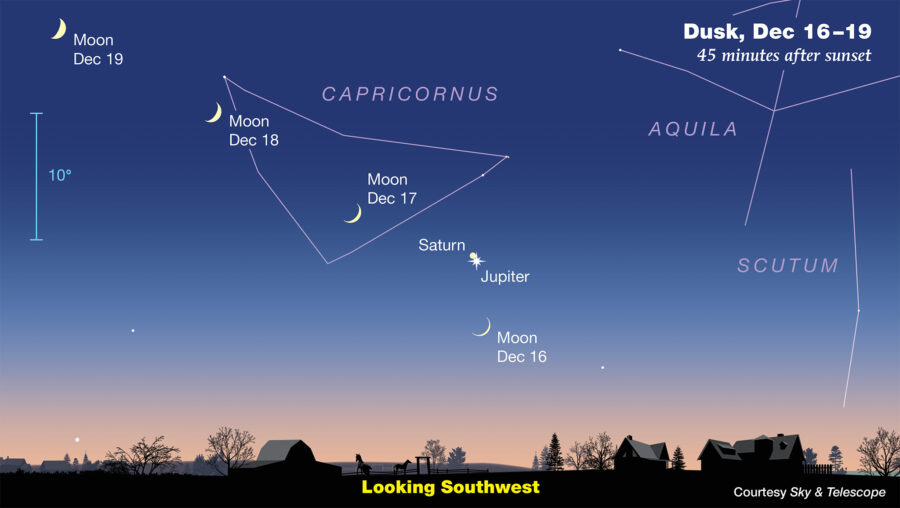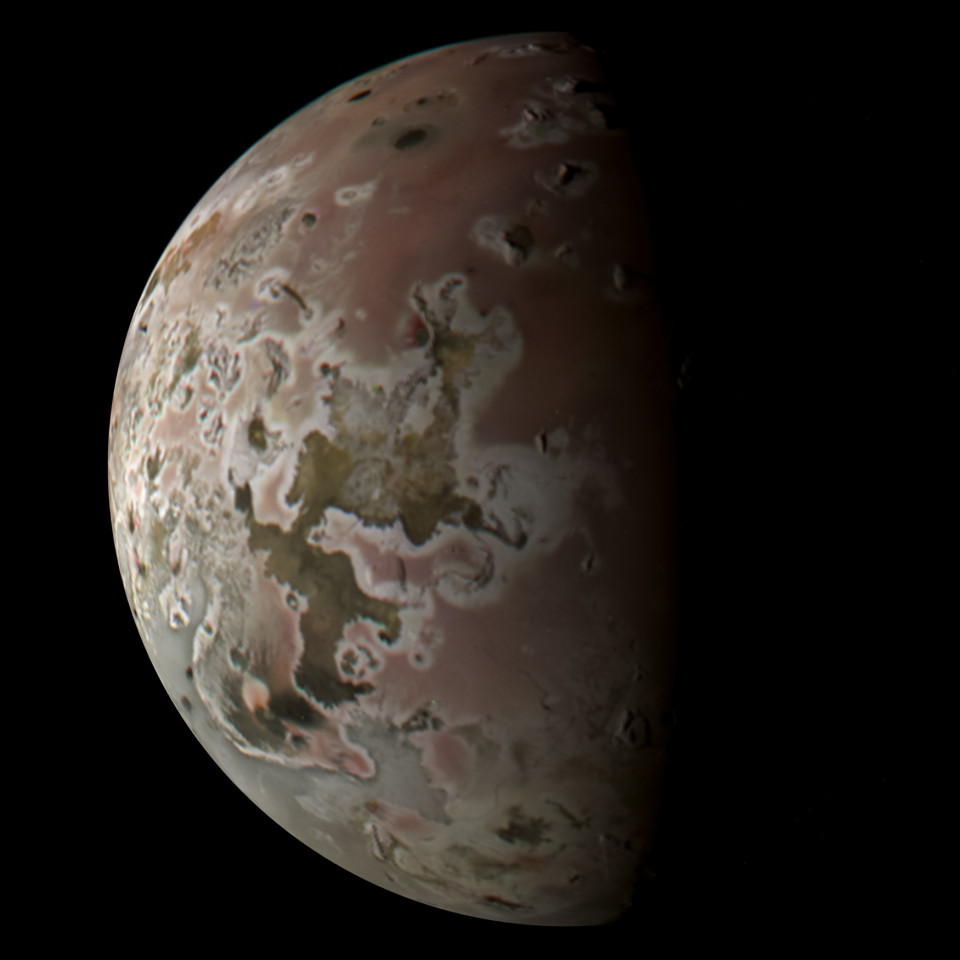Don’t miss the upcoming close conjunction of Jupiter and Saturn on December 21st!
Contacts:
Gary Seronik
Consulting Editor, Sky & Telescope
[email protected]
Diana Hannikainen
Observing Editor, Sky & Telescope
+1 855-638-5388 x22100
[email protected]
Rick Fienberg
Press Officer, American Astronomical Society
+1 202-328-2010 x116
[email protected]
Note to Editors/Producers: This release is accompanied by high-quality graphics; see the end of this release for the images and links to download.
As an eventful 2020 draws to a close, the solar system’s two largest planets meet in the evening in a "Great Conjunction," nearer each other on the sky than they have been for nearly 400 years.
“Witnessing this special event couldn’t be easier,” says Gary Seronik, consulting editor at Sky & Telescope. “On Monday, December 21st, which coincidentally marks the solstice, simply step outdoors roughly 45 minutes after sunset, face southwest, and look about 15° above the horizon — that’s a span slightly greater than the width of your fist seen at arm’s length.”
You should easily spot Jupiter, the brighter of the two planets. Saturn will be to its upper right, but because Jupiter is more than 10 times brighter and so close to Saturn, the ringed planet might be tricky to spot initially. This is where binoculars come in handy — even with minimal optical aid, locating Saturn should be easy.
And if you have a telescope, you’ll get the rare chance to see the planetary twosome occupying the same field of view. The sight will also include Jupiter’s four brightest moons and at least one of Saturn’s — that’s an astonishing seven worlds in a single telescopic view!
At their closest, the two planets will be separated by just 1/10° — that’s only about 1/5th the width of the full Moon. Of course, this tight pairing is merely a line-of-sight effect: In space, Saturn is actually more than 730 million kilometers (450 million miles) behind Jupiter, which is itself 890 million km (550 million miles) from Earth.
For about 5 days before and after December 21st, the two planets will appear within one Moon diameter of each other. This means that if the weather doesn’t cooperate on the 21st, skywatchers will have several other opportunities to see the two planets quite close together. Once Jupiter and Saturn part company this month, they won’t meet up again until 2040. That year’s conjunction will be farther apart.
“So start watching now, tonight — you won’t want to miss every opportunity you can get to witness this amazing sight,” Gary Seronik urges.
The December 21st event is something stargazers refer to as a conjunction, though appulse is the more technically correct term. How rare is this particular one? The last time Saturn and Jupiter were comparably close was in 1623, though it’s possible few saw that conjunction because the planets were positioned closer to the Sun in the sky and awash in bright twilight. Telescopes in 1623 were still a rare novelty — it was, after all, less than 14 years after Galileo made his initial groundbreaking astronomical observations. The most recent readily observable Jupiter-Saturn conjunction that was as close as this year’s occurred in 1226 — around the time Genghis Khan’s career as a conqueror was nearing its end.
Read more on this historic conjunction in the December 2020 issue of Sky & Telescope and on S&T's website: Jupiter and Saturn Embrace in Solstice Conjunction.
Sky & Telescope is making the illustrations below available to editors and producers. Permission is granted for nonexclusive use in print and broadcast media, as long as appropriate credits (as noted) are included. Web publication must include a link to skyandtelescope.org.

Sky & Telescope / Gregg Dinderman

Sky & Telescope / Gregg Dinderman
For skywatching information and astronomy news, visit skyandtelescope.org or pick up Sky & Telescope magazine, the essential guide to astronomy since 1941. Sky & Telescope and SkyandTelescope.org are published by the American Astronomical Society, along with SkyWatch (an annual beginner's guide to the night sky) as well as books, star atlases, posters, prints, globes, apps, and other products for astronomy enthusiasts.
The American Astronomical Society (AAS), established in 1899, is the major organization of professional astronomers in North America. Its membership (approx. 8,000) also includes physicists, mathematicians, geologists, engineers, and others whose research interests lie within the broad spectrum of subjects now comprising the astronomical sciences. The mission of the American Astronomical Society is to enhance and share humanity's scientific understanding of the universe, which it achieves through publishing, meeting organization, science advocacy, education and outreach, and training and professional development.
 0
0









Comments
You must be logged in to post a comment.